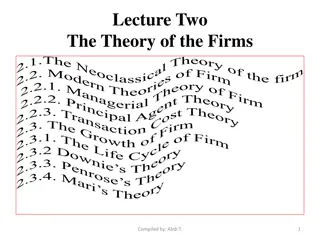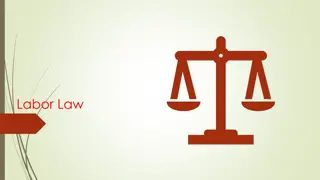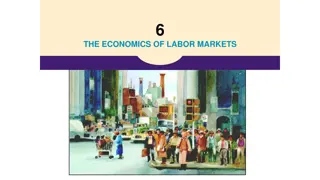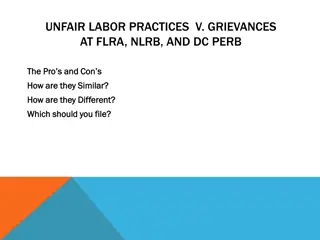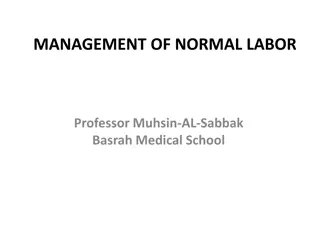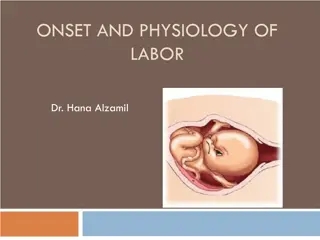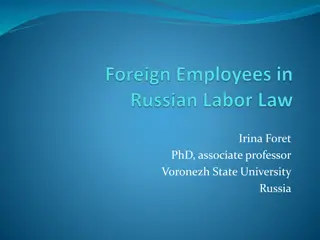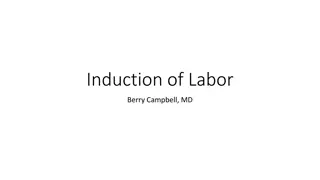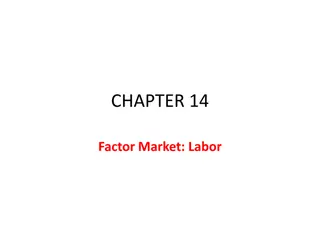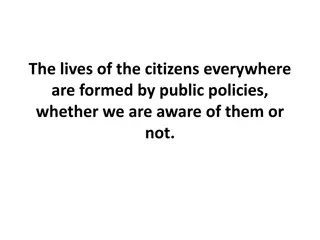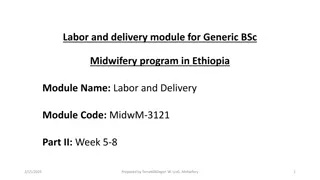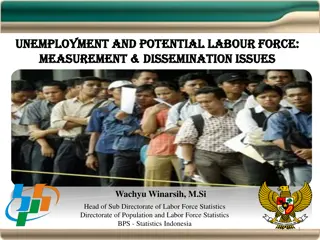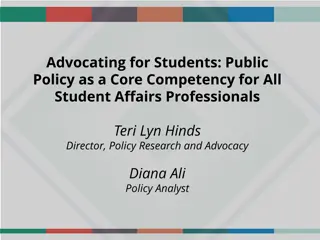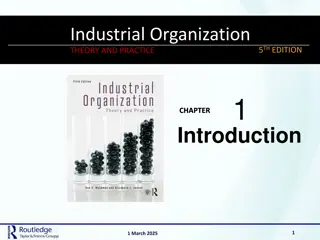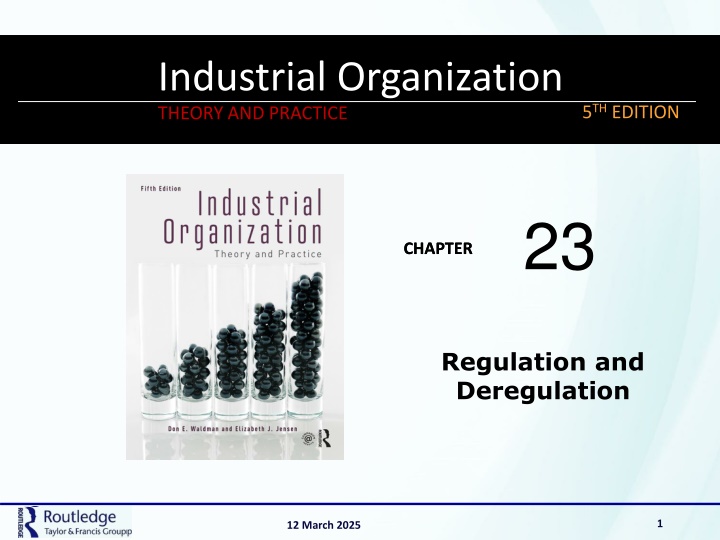
Modern Labor Economics Theory and Public Policy
This article delves into the rationale for economic regulation with a focus on traditional public utility regulation. It explores the historical context, policy dilemmas, and compromises associated with natural monopolies.
Download Presentation

Please find below an Image/Link to download the presentation.
The content on the website is provided AS IS for your information and personal use only. It may not be sold, licensed, or shared on other websites without obtaining consent from the author. If you encounter any issues during the download, it is possible that the publisher has removed the file from their server.
You are allowed to download the files provided on this website for personal or commercial use, subject to the condition that they are used lawfully. All files are the property of their respective owners.
The content on the website is provided AS IS for your information and personal use only. It may not be sold, licensed, or shared on other websites without obtaining consent from the author.
E N D
Presentation Transcript
MODERN LABOR ECONOMICS THEORY AND PUBLIC POLICY THEORY AND PRACTICE Industrial Organization 12THEDITION 5THEDITION 23 CHAPTER CHAPTER Regulation and Deregulation 1 12 March 2025
23.1 The Rationale for Economic Regulation: Traditional Public Utility Regulation The authority for regulation of private industry comes from no less a source than the Constitution of the United States, which declares that Congress has the right to regulate commerce among the several states. Despite this constitutional mandate, for the first century of the nation s existence there was virtually no federal regulation over the day-to-day operation of business. In the latter half of the 19th century, however, the increasing significance of economies of scale in many sectors resulted in increased market power for some firms. Nowhere was this increase in potential power more dramatic than in the railroad industry in the Midwest and West. Because of the monopoly power of the railroads in sparsely populated areas, farmers were forced either to pay high shipping rates or to watch their grain spoil. As economic pressures grew, two important agrarian political groups arose: the Populists and the Grangers. These groups were able to support a candidate for President and to win a number of seats in Congress. As the influence of the Populists and Grangers grew, the two major parties were forced to address their economic concerns, and two policies emerged antitrust and regulation. 12 March 2025 2
23.1 The Rationale for Economic Regulation: Traditional Public Utility Regulation The initial economic rationale for regulation was based on the existence of large economies of scale. The figure shows the typical example of a natural monopoly in the production of a single commodity. The LRAC curve in is sloping downward where it intersects the demand curve at an output of ?1 Least-cost production thus requires having only one firm; moreover, a single firm can expand its output, lower its costs, and monopolize the industry. Because the LRAC curve is sloping downward at ?1, LRMC must lie below LRAC. 12 March 2025 3
23.1 The Rationale for Economic Regulation: Traditional Public Utility Regulation Allocative efficiency demands that output be expanded as long as price is above LRMC or until output equals ?2 If a private firm were forced to expand output to ?2 and charge price ?2, price would be below LRAC and the firm would sustain an economic loss equal to the gray area. Thus there is a policy dilemma associated with a natural monopoly. If an unregulated firm were free to maximize profits, it would produce the profit- maximizing output ?? charge the profit-maximizing price ?? and earn excess economic profits equal to the blue area. Entry would be virtually impossible because the natural monopolist would have a large first- mover advantage and could quickly expand output to ?1if threatened with entry. In the absence of new technology, the monopolist could earn these excess profits indefinitely. If the government attempted to force the natural monopolist to charge the socially optimal price, ?2, then the monopolist would sustain an economic loss, no investors would be attracted to the industry, and the industry would have to be subsidized or it would cease to exist. The middle ground is for regulators set price equal to average cost (?1) With P=AC, economic profits are normal, so investors can be attracted into the industry, and although output is less than the socially optimal output, it is considerably greater than the profit-maximizing output This compromise price known as a Ramsey price, the price that maximizes total social benefits subject to the requirement that profits cannot be negative 12 March 2025 4
23.2 The Workings of American Regulation Although the first state regulatory boards were established in 1874, regulation at the national level did not begin until 1887 with the establishment of the Interstate Commerce Commission (ICC). The legal foundation for the ICC was an 1877 Supreme Court decision, Munn v. Illinois. Illinois had set the maximum price to store grain in warehouses throughout the state. Munn sued, but the Supreme Court ruled in favor of the state. Chief Justice Waite wrote: Looking, then, to the common law from whence came the right which the Constitution protects, we find that when private property is affected with a public interest it ceases to be jurisprivati only. . When, therefore, one devotes his property to a use in which the public has an interest, he, in effect, grants to the public an interest in that use and must submit to be controlled by the public for the common good to the extent of the interest he has thus created. The Munn decision eventually led to the establishment of many regulatory commissions in the United States. Commissioners are appointed by the executive branch of government: the President at the federal level, or the governor at the state level. Most commissions are dominated by lawyers and former politicians and include few, if any, economists. 12 March 2025 5
23.2 The Workings of American Regulation Public utility commissions have several major tasks. Commissions have the difficult job of simultaneously setting the permitted level of profits, the price level, the price structure, and the rate base. None of these tasks is more important than setting the correct level of profits. The target profit level is typically set as a permitted rate of return on invested capital. Profit rates must be high enough to ensure a flow of capital, but not so high as to generate large excess profits. In establishing a price structure, the commission must decide how much price discrimination to permit. Finally, the commission must determine the rate base, or the value of the firm s invested capital to be used to calculate profits. A decision to allow too much capital into the rate base calculation will result in profits being excessive A decision to squeeze the rate base will prevent needed capital from entering the industry. 12 March 2025 6
23.2 The Workings of American Regulation 23.2.1 Setting the Permitted Rate of Return The commission must set the permitted rate of return r, the permitted price structure p, and the permitted rate base K in the following equation: ? =?? ?? ? where r represents the rate of return on invested capital, TR represents total revenue, TC represents total costs, and K represents the value of the firm s invested capital or the rate base. If r is fixed at a too low level, investors will stay away from the utility s stocks and bonds, and capacity may lag behind demand requirements. Insufficient capacity could cause a regulator s worst nightmare a service interruption. However, if r turns out to be too high, output will be restricted below a more socially optimal level, and high profits may cause a public outcry against both the commission and the utility. The value of r goes a long way toward determining the stock value of the company and, therefore, is extremely important to the firm. 12 March 2025 7
23.2 The Workings of American Regulation 23.2.1 Setting the Permitted Rate of Return Suppose, that a utility s stock is worth 10 times its annual profit flow, that is, the utility s price/earnings ratio equals 10. If the target value of r is set at 10 percent and K=$10 million, then targeted annual profits (TR-TC) are $1 million. The utility s stock value should then be 10 times $1 million, or $10 million. Now suppose the utility convinces the commission to raise the target r to 11 percent. If K remains fixed at $10 million, permitted target profits increase to $1.1 million, and the value of the utility s stock should increase to 10 times $1.1 million, or $11 million. There is an immediate $1 million capital gain to stockholders because of the increase in the target value of r. It is obviously worth a great deal of time and effort on the part of stockholders to lobby for an increase in r. How does a commission set the targeted r? Commissions have generally considered three criteria: 1. the cost of raising capital, 2. the utility s capital attraction requirements (whether the utility should be expanding or contracting its capacity), 3. comparable returns in other equal risk industries that would permit the utility to earn a normal economic profit. 12 March 2025 8
23.2 The Workings of American Regulation 23.2.1 Setting the Permitted Rate of Return Historically, commissions have often relied on the third criterion, the concept of comparable returns, which means that the utility should earn a rate of return equal to the average in similar industries. Although this criterion may initially seem to make economic sense, one realizes on second thought that there are no unregulated industries that are comparable to public utilities. Risk to a public utility is so fundamentally different from risk to a firm in an unregulated industry that it is virtually impossible to compare the two. Even if IBM typically earns a 15 percent rate of return, it still runs a risk of sustaining an economic loss in any given year, but if Consolidated Edison is targeted to earn a comparable rate of return of 15 percent, it runs virtually no risk of sustaining an economic loss in any year. Because of the problems associated with using comparable returns, economists have argued that it makes more sense to rely on the cost of raising capital and the firm s capital attraction requirements when setting the target r. The cost of capital is calculated as a weighted average of the firm s cost of raising capital through the three standard securities: bonds, preferred stocks, and common stocks. 12 March 2025 9
23.3 Efficiency Problems Associated with Rate of Return Regulation 23.3.1 X-Inefficiency Rate of return regulation causes serious efficiency problems. With r guaranteed, there is little incentive for the utility to minimize costs, and this encourages X-inefficiency. Because X-inefficiencies increase total costs and cause r to fall below the permitted level, they may precipitate a request to increase prices. Although a commission can deny a price hike if it determines that X-inefficiencies exist, most price increase requests are approved. An institutional check against X-inefficiency is regulatory lag. Regulatory lag exists whenever costs increase or decrease. If costs increase, the utility cannot immediately raise prices. It must first request a price increase. Until the price hike is approved, the utility will earn a rate of return less than r. Similarly, if costs decrease, the utility will earn a rate of return greater than r until a price reduction is approved. Regulatory lag punishes X-inefficiency and rewards improved efficiency. 12 March 2025 10
23.3 Efficiency Problems Associated with Rate of Return Regulation 23.3.2 The Averch-Johnson Effect Another efficiency problem associated with public utility regulation was first suggested by Averch and Johnson, who theorized that if r is greater than the market cost of capital, s, the utility has an incentive to use too much capital relative to other inputs. If r=10 percent and s=8 percent, for example, then every $1 increase in K costs the utility 8 cents but results in a 10-cent increase in permitted profits. The utility is guaranteed an extra 2 cents in profits for every additional $1 it invests in capital. The utility would thus consider its cost of capital to be approximately 6 percent, or s (r s) = 2s r. In the figure, the blue isoquants show the combinations of labor and capital that the regulated firm can use to produce outputs of ?1 and ?2. In the absence of regulation, each blue dashed isocost line has a negative slope equal to the ratio of the price of labor over the price of capital, w/s. 12 March 2025 11
23.3 Efficiency Problems Associated with Rate of Return Regulation 23.3.2 The Averch-Johnson Effect To minimize the cost of producing any quantity, a firm must produce at a point on the relevant isoquant at which the isocost line is tangent to the isoquant. The input expansion path, OA, shows all the possible cost-minimizing combinations of labor and capital in the absence of regulation. Because the line OA identifies the lowest possible social cost of producing any possible output, it is the socially optimal input expansion path. According to the Averch Johnson effect, the cost of capital to the utility becomes 2s-r, which is lower than the social cost of capital, s. Consequently, the isocost lines under regulation are steeper; the black isocost lines have a slope of w/(2s-r) OB shows the input expansion path under regulation. For any output, a regulated firm uses more capital and less labor than it would along the socially optimal expansion path. 12 March 2025 12
23.3 Efficiency Problems Associated with Rate of Return Regulation 23.3.2 The Averch-Johnson Effect According to Averch and Johnson, the regulated utility will invest in too much capital and select a nonoptimal combination of inputs. A good deal of empirical evidence gathered in the in 1950s and 1960s supported the existence of an Averch-Johnson effect. However, some economists have theorized that regulation results in the use of too few units of capital relative to other inputs. One alternative hypothesis suggests that firms may underinvest in capital because they fear that future regulations will be tightened. Tighter future regulation would cause a lower permitted rate of return on invested capital. By underinvesting in capital, regulated firms limit the potential damage associated with a lower rate of return in the future. Some empirical studies have failed to find evidence of an Averch Johnson effect, and at least one study found evidence of undercapitalization. 12 March 2025 13
23.3 Efficiency Problems Associated with Rate of Return Regulation 23.3.3 Setting the Price Structure with Decreasing Costs From the end of World War II through the early 1970s, utilities faced declining long-run average cost curves. To increase output toward the socially optimal level, commissions permitted the use of price discrimination. The figure shows how, under conditions of decreasing LRAC, second-degree price discrimination can enable a utility to produce the socially optimal output and earn a normal profit. Under second-degree price discrimination, buyers are offered a price schedule based on their willingness to pay. In response, customers divide themselves into three groups: residential buyers, small commercial buyers, and large commercial buyers. Residential buyers pay the highest price, ?1, small commercial buyers pay a lower price ?2, and large commercial buyers pay a price equal to marginal cost, ??? Because total output is ?3, the average cost of production is AC=?2 for all units produced. 12 March 2025 14
23.3 Efficiency Problems Associated with Rate of Return Regulation 23.3.3 Setting the Price Structure with Decreasing Costs The utility earns a positive economic profit equal to the blue area on sales to residential users, earns a normal profit on sales to small commercial users, and sustains an economic loss equal to the gray area cdef on sales to large commercial buyers. If the blue area equals the gray area, the utility earns a normal economic profit and output is equal to the socially optimal output. Commissions have also permitted third-degree price discrimination. In the telecommunications industry, for example, customers have been separated into business and residential buyers. Business customers have a more inelastic demand and pay higher rates. 12 March 2025 15
23.3 Efficiency Problems Associated with Rate of Return Regulation 23.3.3 Setting the Price Structure with Increasing Costs In the early 1970s, cost conditions changed dramatically as the price of oil and other fossil fuels increased. Electric utilities suddenly faced an entirely new cost structure as variable fuel costs became a significant component of total costs and conservation became a high national priority. In addition, high inflation and interest rates increased the cost of expanding capacity. Almost overnight, marginal costs and average costs were increasing instead of decreasing, and the optimal pricing structure no longer called for discrimination in favor of large users but, instead, required efforts to reduce demand. After 1974, the marginal cost of generating electricity was significantly higher during peak demand periods when the last kilowatt-hour of generating capacity had to be brought on line. A typical electric utility, for example, would use only its low-cost hydroelectric or nuclear power capacity during off-peak periods. As demand increased during the day, newer fossil fuel facilities would be used. Finally, as demand reached peak, aging and inefficient facilities would be brought on line. With each increase in demand, therefore, the marginal cost of generating a kilowatt-hour of electricity would increase. The entire cost of operating the last inefficient units of generating capacity, including depreciation, should be allocated to those last units of peak demand. 12 March 2025 16
23.3 Efficiency Problems Associated with Rate of Return Regulation 23.3.3 Setting the Price Structure with Increasing Costs The figure shows the post 1974 cost structure. Suppose demand equals ?? during the peak period from 8:00 a.m. to 10:00 p.m., and demand equals ??? during the off-peak period from 10:00 p.m. to 8:00 a.m. Efficient pricing requires charging ?? during the peak period and ??? during the off-peak period. The first electric utility to adopt a peak-load pricing system was the Wisconsin Power & Light Company in 1977. Wisconsin Power & Light charged commercial users 2.03 cents per kilowatt-hour between 8:00 a.m. and 10:00 p.m. and 1.013 cents per kilowatt-hour between 10:00 p.m. and 8:00 a.m. After 1977, many states incorporated peak-load pricing schemes into their price structures. 12 March 2025 17
23.4 The Spread of Regulation in Other Markets 23.4.1 The Capture Theory of Regulation The existence of large economies of scale was used to justify regulation in the railroad industry and the traditional public utilities, such as electricity, gas, and telecommunications. But regulation also spread to markets in which economies of scale were not significant, possibly because the regulated firms captured control of the regulatory commissions. According to this capture theory, once the railroads were regulated, the commissions came to view their primary responsibility as protecting the regulated firms from too much competition, rather than protecting consumers from monopoly prices. As a result, regulation spread into other transportation industries. Stigler first suggested that regulation is supplied in response to interest group lobbying pressure to protect the group from competition. Peltzman expanded on Stigler s theory by suggesting that legislators select regulatory policies that maximize the legislators political support. Interest groups provide votes, campaign contributions, and other campaign resources to the legislators. In turn, the legislators provide support in the form of wealth transfers to the interest groups that provide the most votes and resources. 12 March 2025 18
23.4 The Spread of Regulation in Other Markets 23.4.1 The Capture Theory of Regulation To formalize the model, suppose there are n firms in an industry that benefits from regulation. Assume the following: 1. Regulation results in a wealth transfer of T from consumers to the n firms. 2. The cost of organizing firms to lobby is a function of the number of firms n, and equals C(n), which is a positive function of n because it is more difficult and costly to organize a large group than a small group. 3. The incentive for consumers to lobby against regulation increases with an increase in the total number of consumers negatively impacted by regulation and an increase in the intensity of consumers feelings. The per capita net benefits of regulation for each firm i then equal: ??=? ?(?) ? As n decreases, T/n increases, C(n) decreases, and C(n)/n may increase, decrease, or remain constant. If C(n)/n decreases or remains constant, the net benefits of regulation must increase with a decrease in n. Even if C(n)/n increases, it is likely that the increase in T/n will be greater, so reducing n is likely, therefore, to increase the per capita net benefits associated with regulation and increase the intensity of the groups lobbying effort. =? ? ?(?) ? 12 March 2025 19
23.4 The Spread of Regulation in Other Markets 23.4.1 The Capture Theory of Regulation One of the major implications of the Peltzman model is that regulation tends to benefit small, well-organized groups with strong feelings (e.g., regulated firms) at the expense of large, unorganized groups with weak feelings (e.g., consumers). The history of regulation of transportation industries is consistent with the Stigler/Peltzman theory: the railroads were a well-organized, small group with a great deal to gain from expanded regulation into the trucking, busing, water carrier, and airline industries. Ironically, as time passed, regulation came to favor the trucking industry at the expense of the railroads. Occupational licensing in the professions provides another example of how the regulatory process can be captured and brought under the control of those being regulated. Professional organizations of doctors, lawyers, electricians, engineers, and plumbers have been able to convince state legislatures to establish licensing regulations and allow the professional organizations to set the licensing rules themselves. Doctors decide who can practice medicine, and lawyers decide who can practice law. These self-imposed regulations typically make entry difficult and result in higher incomes for those already licensed. Additional evidence in support of the capture theory is provided by the aggressive opposition of regulated firms to deregulation. 12 March 2025 20
23.5 The Movement from Regulation to Deregulation The 1970s and 1980s brought a dramatic move away from regulation. Though fully regulated industries produced 17 percent of GNP in 1977, they produced only 6.6 percent by 1988. This move toward deregulation continued into the 1990s. In part, this is due to the development of new technologies that have reduced the incidence of natural monopoly thereby decreasing the number of justified areas for regulation. Also, supporters of deregulation pointed to the efficiency problems associated with regulation such as those discussed earlier, arguing that deregulation would increase efficiency and lower prices. 23.5.1 Surface Transportation Despite the efforts of the ICC to protect the railroads, their competitive position declined after World War II. The development of the interstate highway system combined with the growth of the commercial airline industry destroyed the railroads passenger business, which declined from 50 billion passenger-miles in 1940 to 22 billion in 1960 and 10 billion in 1975. The railroads argued that the government unfairly subsidized competing modes of transportation. 12 March 2025 21
23.5 The Movement from Regulation to Deregulation 23.5.1 Surface Transportation For example, while the government built the interstate highway system and new airports, the railroads had to use their own funds to build and maintain their rail beds. The government permitted truck carriers to use collusion and price discrimination to compete with the railroads, and the ICC was slow to allow the railroads to reduce rates in response to discriminatory price cutting by truckers. By 1960, the railroads were in deep financial trouble. The ICC responded by encouraging mergers and permitting service reductions, but the commission still refused to permit major rate cuts. Under pressure from the railroads to deregulate, in 1976, Congress passed the Railroad Revitalization and Regulatory Reform Act, which 1. provided $1.6 billion in government subsidies; 2. increased price flexibility; 3. accelerated the pace of merger approvals; 4. expedited the closing of low-volume rail routes. The 1976 act did not go far enough, however, and in 1980 Congress passed the Staggers Act, which authorized more subsidies, eliminated antitrust immunity, and permitted greater price flexibility. 12 March 2025 22
23.5 The Movement from Regulation to Deregulation 23.5.1 Surface Transportation Deregulation resulted in immediate improvements in the railroads economic performance. First, the railroads eliminated many unprofitable routes. Between 1975 and 1982, the railroads abandoned 17.2 percent of their track miles. Deregulation also enabled the railroads to increase rates in markets in which they had a comparative advantage, such as the transportation of bulky commodities like coal, and decrease prices in markets in which they faced stiff competition. Overall, rail prices decreased by 17.5 percent between 1975 and 1983. To level the playing field, in 1980, Congress also passed the Motor Carrier Act, partially deregulating the trucking industry. This act, which was strongly opposed by the large truck carriers, eased entry and allowed greater price flexibility. Before 1980, regulation prevented entry into trucking if existing truckers could meet demand. Given this restriction, most entry requests were denied. 12 March 2025 23
23.5 The Movement from Regulation to Deregulation 23.5.1 Surface Transportation The table shows the dramatic impact of the 1980 Motor Carrier Act on entry. Requests for entry authority by truckers increased dramatically after deregulation, and the percentage of requests granted increased as well. One striking figure is the 60.7 percent increase in the number of carriers between 1975 and 1982. Entry caused rates for truckload carriers to decline by 25 percent in this period. As prices fell, profits were squeezed, and the number of trucking bankruptcies increased 400 percent between 1980 and 1985. Deregulation of surface transportation resulted in improved economic efficiency. Inefficient firms closed down, costs fell, and rates declined. Railroad profits increased, and trucking profits decreased. 12 March 2025 24
23.5 The Movement from Regulation to Deregulation 23.5.2 Airline Regulation and Deregulation Regulation of the airline industry began in the 1920s, when the United States Postal Service was authorized to award mail routes and set rates. In 1934, the ICC took over the regulation of mail carriage and set up a competitive bidding system to allocate routes. To ensure a flow of mail traffic, the airlines continuously bid under cost, and soon many were on the verge of bankruptcy. Congress responded to this threat to the airlines by passing the Civil Aeronautics Act of 1938, which established the Civil Aeronautics Authority. In 1940, the Civil Aeronautics Authority became the Civil Aeronautics Board (CAB). The CAB controlled the industry until the early 1980s and had complete control over rates, entry, and exit. The CAB set fares to earn a target rate of return on investment, and the fares had little relationship to costs. Average costs per passenger-mile were significantly higher on short routes than on long routes. Fares, however, were related primarily to distance, so they were maintained well above average cost on long routes. 12 March 2025 25
23.5 The Movement from Regulation to Deregulation 23.5.2 Airline Regulation and Deregulation These high fares subsidized below-average-cost fares on short routes. Price changes tended to be across-the-board, and the CAB discouraged price competition. Entry was approved only if it would not harm existing carriers. Finally, inefficient carriers that were in danger of sustaining economic losses were rewarded with new, profitable routes to keep them from going bankrupt. Between 1949 and 1969, passenger-miles increased at an average annual rate of 14 percent, while the average fare per mile decreased by 2 percent. During this period, the Consumer Price Index (CPI) increased by 50 percent. The decline in real airfares resulted from a 22 percent decrease in the average cost per passenger-mile. In the late 1960s, the impact of regulation first came into serious question when it was discovered that fares on unregulated intrastate routes were much lower than fares on comparable regulated routes. In the absence of price competition, the airlines turned to various forms of nonprice competition, which took the form of increased frequency of flights and more amenities. As the airlines kept adding extra flights, empty seats abounded and load factors were low. In 1969, only 50.3 percent of available seats were filled, and these low loads increased average costs and reduced profits. 12 March 2025 26
23.5 The Movement from Regulation to Deregulation 23.5.2 Airline Regulation and Deregulation In 1976, the CAB took its first tentative steps toward deregulation when it permitted charter flight operators to reduce fares on advance purchase tickets with a minimum stay requirement. In 1977, the CAB allowed certain major carriers to lower fares by 45 percent on Super Saver transcontinental flights if the tickets were purchased at least 30 days in advance and were for a minimum seven-day stay. When economist Alfred Kahn became chair of the CAB in June 1977, he announced that his goal was to eliminate all regulation of fares and entry and to ultimately disband the CAB. Under Kahn, the CAB began permitting fare reductions of up to 70 percent and fare increases of up to 10 percent. Over the protests of the major airlines, Congress passed the Airline Deregulation Act (ADA) in October 1978. The ADA ended the CAB s route authority effective December 1980 and its fare authority effective January 1983, abolished the CAB at the end of 1984, and transferred the CAB s remaining authority over antitrust and international matters to the Department of Transportation (DOT). 12 March 2025 27
23.5 The Movement from Regulation to Deregulation 23.5.2 Airline Regulation and Deregulation Deregulating the industry in 1979 proved to be unfortunate. In 1979, the Shah of Iran was overthrown, causing oil prices to increase to $34 per barrel, at the time an all-time high. As a result, the price of jet fuel jumped from 40 cents to over 60 cents per gallon. High oil prices precipitated a severe worldwide recession that greatly reduced the demand for air travel. Despite these economic problems, entry occurred after deregulation. Midway entered in 1979, New York Air in 1980, and People Express in 1981. Furthermore, several of the larger carriers, such as Pacific Southwest Airlines and Southwest Airlines, entered the interstate market. In addition, most of the major airlines expanded into new territories. The effect was an explosion of new competition. The new carriers had significantly lower costs than the established airlines and were able to compete effectively based on lower fares. One major advantage for the new airlines was a nonunionized labor force. The major carriers were also saddled with a large fleet of 747 and DC-10 jumbo jets, which could not be used efficiently on the more price-competitive middle- and short- distance routes. 12 March 2025 28
23.5 The Movement from Regulation to Deregulation 23.5.2 Airline Regulation and Deregulation In addition, the entrants reduced maintenance costs by relying on one or two types of aircraft, and they squeezed more seats into their planes. Further cost reductions were achieved by reducing in-flight amenities. The increase in competition and reduction in costs led to a sharp decline in fares in those large cities where a new low-cost airline entered. Between 1975 and 1983, after adjusting for inflation, the average price per passenger- mile declined by 8.5 percent. The major carriers left the smaller markets, and small-market fares tended to increase. The increase in small-market fares was expected because regulation had highly subsidized service to small cities. The overall fare reductions forced several large carriers into bankruptcy; victims included Braniff and Continental. Continental took advantage of bankruptcy to destroy its unions, reduce costs, and reemerge as a low-cost, low-price carrier. 12 March 2025 29
23.5 The Movement from Regulation to Deregulation 23.5.2 Airline Regulation and Deregulation One of the most dramatic impacts of deregulation was the development of the hub- and-spoke system. Under regulation, many passengers were forced to change airlines on medium or long trips. Under deregulation, the airlines quickly learned that passengers preferred to stay with one carrier. By creating hubs and channeling passengers into and out of these hubs, the airlines could prevent most passengers from changing airlines. The hub-and-spoke system also reduced costs by allowing the airlines to rely on smaller, more efficient planes. Before long, all of the successful airlines were structured around a hub-and-spoke system. The system enabled several regional airlines, such as U.S. Airways and Piedmont, to expand into national carriers. 12 March 2025 30
23.5 The Movement from Regulation to Deregulation 23.5.2 Airline Regulation and Deregulation Deregulation has had many positive effects; fares have declined, the number of flights has increased, productivity has improved, and capacity utilization has increased. Problems, however, appeared as concentration has increased, in part because the Department of Transportation (DOT) failed to prevent a number of anticompetitive mergers even after the Department of Justice (DOJ) opposed them. In 1986, for example, the TWA Ozark and Northwest Republic mergers were both opposed by the DOJ but were approved by the DOT. In just the three short years of 1985 to 1987, 20 mergers were approved. Although the DOJ blocked a merger proposed in May 2000 between United Airlines (the nation s largest carrier at the time) and U.S. Airways (the sixth largest carrier), it approved the acquisition of TWA and its St. Louis hub monopoly by American Airlines in 2001. Recent years have seen three megamergers in the U.S. airlines industry, and merger talks continue between other large carriers. Additionally, the antitrust agencies and the DOT have allowed the major carriers to enter into a variety of affiliations and partnerships that have given them considerable control over many of the leading regional and commuter carriers and have not been aggressive in attacking barriers to entry such as slots, gates, and airport ground facilities. 12 March 2025 31
23.5 The Movement from Regulation to Deregulation 23.5.2 Airline Regulation and Deregulation On the other hand, the DOJ challenged the communication and signaling practices of the airlines computer reservation systems in the mid-1990s, accusing them of collusive behavior. Government lawyers filed an antitrust suit against American Airlines in 1999, alleging that American used predatory pricing to eliminate new competitors in its Dallas Fort Worth hub. The future of the airline industry, and of policy toward the industry, remains somewhat up in the air. 23.5.3 Electricity In 1935, Congress passed the Public Utility Act establishing the Federal Power Commission (FPC) to regulate the interstate aspects of the electricity industry. The Department of Energy Organization Act of 1977 transferred authority over interstate electricity regulation to the Federal Energy Regulatory Commission (FERC). 12 March 2025 32
23.5 The Movement from Regulation to Deregulation 23.5.3 Electricity Vertical integration is extremely important in the electricity industry. There are three vertical stages: generation, transmission, and distribution. Economies of scale are significant at the transmission and distribution stages, but less significant at the generation stage. There is a significant amount of government ownership in electricity. The federal government owns facilities that generate approximately 10 percent of all electricity. State and local governments control approximately 10 percent of distribution services. Given current cost structures, there is little disagreement that the transmission and distribution sectors are still natural monopolies. The debate over deregulation is centered on the generation stage, in which economies of scale are much less significant. Generation typically has accounted for over 50 percent of total industry costs, so deregulation of generation would have a significant impact. If vertical integration were dissolved resulting in independent generation, transmission, and distribution companies, most regions could support multiple generation companies and a reasonable level of competition. 12 March 2025 33
23.5 The Movement from Regulation to Deregulation 23.5.3 Electricity Vertical disintegration and increased competition would likely result in lower industrial rates relative to residential rates because generating companies would compete for large commercial accounts. Deregulation also might result in entry by large, private bulk-power users. A lesson learned from the airlines is that for deregulation to benefit residential consumers, it would have to be accompanied by watchful antitrust policies aimed at preventing mergers that would increase regional concentration. Generating companies also would have to be guaranteed interconnection to transmission lines. 23.5.4 The Natural Gas Industry Vertical integration is also very important in the natural gas industry, in which there are also three vertical stages: production at the wellhead, transportation through pipelines, and distribution. Although economies of scale are highly significant in transportation and distribution, they are insignificant at the production stage 12 March 2025 34
23.5 The Movement from Regulation to Deregulation 23.5.4 The Natural Gas Industry Before 1938, the FPC had no authority to regulate the price of natural gas, and the Supreme Court had ruled that state and local commissions could not set the price of interstate gas. In 1938, Congress passed the Natural Gas Act, which gave the FPC the power to set interstate pipeline rates but exempted producing and gathering operations at the wellhead from regulation. The FPC was also specifically given control over entry in the transmission segment. In order to build an interstate pipeline that served an area already served by another gas line, a company needed FPC approval. In 1954, in Phillips Petroleum v. Wisconsin, the Supreme Court ordered the FPC to begin to regulate the wellhead price of natural gas. Phillips was the largest nonintegrated gas producer in the county. When Phillips raised its rates to the state of Wisconsin, Wisconsin complained to the FPC. The Commission claimed it had no regulatory authority over gas prices, and Wisconsin then sued Phillips. The Supreme Court ruled that although the 1938 act had exempted producing and gathering operations, it had not exempted the subsequent sale of natural gas across state lines and ordered the FPC to expand its authority into pricing at the wellhead. 12 March 2025 35
23.5 The Movement from Regulation to Deregulation 23.5.4 The Natural Gas Industry Initially, the FPC attempted to regulate gas prices using traditional rate of return regulation, but because gas and oil are usually produced together, it was virtually impossible to separate the costs of gas production from the costs of oil production. The FPC divided the country into 23 producing areas and announced temporary price ceilings in each area. A distinction was made between gas produced from old wells and new wells. The price ceiling was higher on new gas to provide an incentive for exploration. Regulation of the wellhead price of natural gas never made economic sense, and this became abundantly clear with the onset of the energy crisis of 1973 1974. As Organization of the Petroleum Exporting Countries (OPEC) increased oil prices, regulation kept the price of natural gas artificially low, in an excess demand for natural gas as consumers rationally attempted to switch from expensive oil and electricity to artificially low-priced natural gas. Price controls also reduced the incentive for exploration. In 1978, Congress passed the Natural Gas Policy Act, which gradually deregulated the price of natural gas at the wellhead. Price ceilings were removed from deep-well gas (wells more than 5000 feet deep) in November 1979 and from new gas in January 1985. Old gas remained under price control until July 1989. Today, the wellhead price of natural gas is unregulated. 12 March 2025 36
23.5 The Movement from Regulation to Deregulation 23.5.5 Financial Markets The financial system is among the most heavily regulated sectors of the United States economy. among the principal regulatory agencies of the financial system are the Securities and Exchange Commission (SEC), the Commodity Futures Trading Commission (CFTC), the Federal Deposit Insurance Corporation (FDIC), and the Federal Reserve System. The tables on the following slides list chronologically the major pieces of U.S. financial legislation and the key provisions of each piece of legislation. 12 March 2025 37
23.5 The Movement from Regulation to Deregulation 12 March 2025 38
23.5 The Movement from Regulation to Deregulation 12 March 2025 39
23.5 The Movement from Regulation to Deregulation 12 March 2025 40
23.5 The Movement from Regulation to Deregulation 23.5.5 Financial Markets Unfortunately, as the financial crisis of 2007 2009 made clear, the process does not always work well. Asymmetric information plays an important role in financial markets. A borrower may have better information than a lender about the potential benefits and costs of a potential investment project. Similarly, a bank s depositors are unable to evaluate fully if bank managers are taking on too much risk or even making fraudulent decisions. Thus, in the absence of any kind of regulation of the banking system, depositors would be reluctant to put any funds into a bank. A lack of information can also lead to bank panics, as happened frequently in the United States in 1819, 1837, 1857, 1873, 1884, 1893, 1907, and 1930 1933 prior to the creation of the FDIC in 1934. If depositors are unable to assess the quality of their banks assets and if there is no insurance on deposits, any adverse shock to the economy unsettles depositors and leads them to withdraw funds by pressuring the banking system as a whole. 12 March 2025 41
23.5 The Movement from Regulation to Deregulation 23.5.5 Financial Markets Asymmetric information in financial markets leads to two problems: adverse selection and moral hazard. Adverse selection occurs prior to a transaction and refers to the fact that borrowers most eager to seek out a loan are the potential bad credit risks, just as the people most likely to buy health insurance are those who expect to experience health problems. Adverse selection leads lenders to be reluctant to make loans even though the lenders know that there are good credit risks as well as bad ones in the market. In contrast to adverse selection, moral hazard occurs after a transaction has taken place. In financial markets, moral hazard is the risk that a borrower, having received the funds, may make decisions that decrease the probability that the loan will be repaid. For example, a borrower may take on riskier projects or monitor activities less carefully. As with adverse selection, the possibility of moral hazard makes lenders more reluctant to engage in transactions. The problems of adverse selection and moral hazard resulting from asymmetric information have shaped financial regulation in the United States and in other countries. 12 March 2025 42
23.5 The Movement from Regulation to Deregulation 23.5.5 Financial Markets Categories of regulation include a government safety net, restrictions on asset holdings, capital requirements, prompt corrective actions, chartering and examination assessment of risk management, disclosure requirements, consumer protection, and restrictions on competition. Because of the importance of a smoothly functioning financial system to the economy, governments throughout the world have enacted these forms of regulation in attempts to mitigate the problems. Not surprisingly, it is easier to understand the theory underlying financial regulation than to get it right in practice. The 2007 2009 Financial Crisis: Contributing Factors Economists have identified three key factors that contributed to the financial meltdown: 1. financial intervention in the mortgage markets, 2. agency problems in those markets, 3. problems with the credit rating process. 12 March 2025 43
23.5 The Movement from Regulation to Deregulation 23.5.5 Financial Markets The 2007 2009 Financial Crisis: Contributing Factors, continued Advances in computer technology and processing power combined with new statistical techniques to bring about dramatic changes in the residential mortgage market. Prior to 2000, only prime borrowers those who were most credit-worthy could get residential mortgages, but the innovations allowed credit scores to be assigned to borrowers with riskier credit records. These changes led to the issuing of subprime mortgages to consumers with less impressive credit records. Additionally, advances in computer software allowed mortgages to be bundled together into debt securities called mortgage-backed securities. The complexity of the financial products made it difficult to value the cash flows of the underlying assets or, sometimes, to even determine the actual owner of the securities. Agency problems also arose in mortgage markets. Because the mortgage brokers who originated the loans quickly sold the loans to investors as securities, the brokers did not have strong incentives to evaluate the riskiness of the loans and assess whether the borrowers could actually pay them off. Even though the brokers were theoretically acting as agents for the investors, in practice, the brokers cared more about volume than about the riskiness of the mortgages. In this environment, adverse selection meant that seekers of subprime loans were often risk- loving investors who would profit by flipping houses if housing prices went up and who would default on their loans if housing prices went down. 12 March 2025 44
23.5 The Movement from Regulation to Deregulation 23.5.5 Financial Markets The 2007 2009 Financial Crisis: Contributing Factors, continued A third problem involved credit-rating agencies. The agencies earned large fees from their clients for advice about structuring the new complicated financial instruments like collateralized debt obligations. At the same time, theses agencies were assigning credit ratings to these instruments. Not surprisingly, this conflict of interest resulted in inflated credit ratings that misled investors about the true risk of the complicated financial products. It took the economy several years to recover from the global financial crisis and the ensuing great recession. With hindsight, we can identify problems with the regulatory system, leading us to consider what has been done in response. As the chairman of the CFTC, Gary Gensler, told the Senate Banking Committee in February of 2011, In 2008, the financial system failed the American public, but the regulatory system, as well, failed the American public. 12 March 2025 45
23.5 The Movement from Regulation to Deregulation 23.5.5 Financial Markets Dodd Frank Wall Street Reform and Consumer Protection Act of 2010 On July 10, 2010, President Obama signed the Dodd Frank Bill into law. This bill is the most comprehensive financial reform legislation since the Great Depression and was regarded as an end to a period of steady deregulation of the financial industry. The bill addresses the following five categories of regulation: Consumer Protection. The Dodd Frank Act created a new Consumer Financial Protection Bureau; this bureau is a branch of the Federal Reserve although there are provisions in the bill intended to preserve the independence of the bureau. The intended purpose of the agency is to protect consumers by correcting some of the problems discussed above. The agency has the authority to examine and enforce regulations for issues of residential mortgages with more than $10 billion in assets The agency is expected to push for requirements for lenders to provide straightforward ( plain English ) information about mortgages and to require lenders to do a more careful job of assessing ability to pay by verifying borrowers income, credit history, and job status. 12 March 2025 46
23.5 The Movement from Regulation to Deregulation 23.5.5 Financial Markets Derivatives Derivatives, or financial derivatives, are financial instruments whose payoffs depend on (derive from) previously issued securities. The Dodd Frank bill requires that most derivatives would be traded on an open exchange rather than being sold by securities dealers who profit from the difference between the prices it pays to buy the securities from one party and the prices at which it sells securities to another party. Exchange trading is intended to improve information available to investors, introduce price competition, and lower profits. Other stipulations of the bill would subject the more complicated, customized derivatives to higher capital requirements and ban banks from dealing in some of the riskier financial products. Volcker Rule This part of the bill is named after Paul Volcker, a former Chairman of the Board of Governors of the Federal Reserve, and is based on his argument that banks whose deposits are federally insured should not be able to take large trading risks trading for their own benefit. Provisions limit the extent of what trading banks can do with their own money and also allow banks to own only a small percentage of hedge and equity funds. 12 March 2025 47
23.5 The Movement from Regulation to Deregulation 23.5.5 Financial Markets Resolution Authority Since its establishment, the FDIC has had the ability to seize failing banks and liquidate them at no cost to taxpayers. However, the government did not have this resolution authority for the largest financial institutions such as Lehman Brothers, something the U.S. Treasury and the Federal Reserve claimed contributed to the crisis. The Dodd Frank bill authorizes regulators to impose restrictions on large financial companies and provides resolution authority to the government for financial firms deemed to be systemic, meaning that their failure would cause widespread damage to the overall financial system. Systemic Risk Regulation The bill created a nine-member council, the Financial Stability Oversight Council, chaired by the Treasury secretary, to designate which financial firms are systemically important; these firms are subject to additional regulation by the Federal Reserve. This council also monitors markets for asset price bubbles, such as in the housing market and for systemic risk. As with the creation of the resolution authority, the objective is to protect the overall financial system. 12 March 2025 48
23.5 The Movement from Regulation to Deregulation 23.5.5 Financial Markets Although the bill was signed into law in July 2010, as of 2018, it was still unclear what the fate of the legislation would be, let alone how it would affect the conduct of financial institutions. The law left literally hundreds of important decisions to be worked out in the rule- making process and things were thrown into chaos by the election of Donald Trump in November 2016. With the Republicans in complete control of Congress, they and the financial industry pushed to rein in the law and overturn some of its provisions. Rule-making is delayed and political wrangling ensued. Moreover, in 2018 a number of key positions in regulatory agencies remain unfilled. In May 2018, Congress rolled back portions of the legislation dealing with the oversight of banks, credit unions, and financial institutions. The bill raised the threshold for mandatory annual stress tests of financial solvency from $50 billion to $250 billion. By increasing the threshold to $250 billion in assets, several high-profile financial institutions, including American Express and Ally Financial, would no longer be subject to the toughest Dodd-Frank regulatory oversight. 12 March 2025 49
23.5 The Movement from Regulation to Deregulation 23.5.5 Financial Markets The bill also exempts banks with less than $10 billion in assets from the Volcker Rule. The smaller banks are also exempted from the Dodd-Frank requirement that they report detailed data on their borrowers. It is impossible to know how things will play out in the long run, but Trump and Congressional Republicans likely will try to roll back more of the regulations imposed on banks by the Dodd-Frank legislation. 12 March 2025 50



